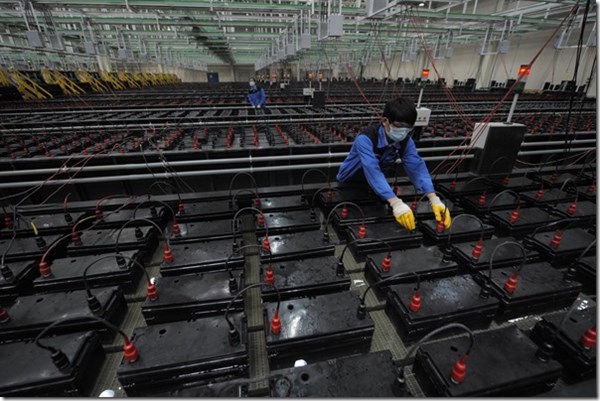What Happens Post-Lead-Acid Batteries to the Lead?
As researchers at MIT point out, at some point, conventional automotive lead-acid batteries are going to give way to improved technologies, such as lithium-ion batteries.
As researchers at MIT point out, at some point, conventional automotive lead-acid batteries are going to give way to improved technologies, such as lithium-ion batteries.
According to Angela M. Belcher, the W.M. Keck professor of Energy at MIT, “Once the battery technology evolves, over 200 million lead-acid batteries will potentially be retired in the United States, and that could cause a lot of environmental issues.”

Johnson Controls battery plant in Changxing
To say nothing of all of the other places in the world—think China—where there are literally millions of cars and consequent batteries.
Belcher says that now, 90% of the lead recovered from old batteries is used to produce new batteries, but if there aren’t new batteries being produced, that’s a lot of lead that is going to quickly pile up.
So she and her colleagues have done some work that may turn that lead into if not exactly gold, at least energy
They’ve determined that it is possible to make solar cells with organolead halide persovskite, which can be derived from car batteries.
The peroskite photovoltaic material is just 0.5-mm thick. A single car battery contains a sufficient amount of lead to produce a sufficient amount of solar cells to power 30 homes.
“It went from initial demonstrations to good efficiency in less than two years,” said Belcher. The power-conversion efficiency is more than 19%, which is said to be close to that achieved by commercial silicon-based solar cells.
RELATED CONTENT
-
On Fuel Cells, Battery Enclosures, and Lucid Air
A skateboard for fuel cells, building a better battery enclosure, what ADAS does, a big engine for boats, the curious case of lean production, what drivers think, and why Lucid is remarkable
-
Mustang Changes for 2018
On Tuesday Ford unveiled—using the social media channels of actor Dwayne Johnson (this has got to unnerve some of the auto buff book editors)—the 2018 Mustang, which has undergone some modifications: under the hood (the 3.7-liter V6 is giving way to a 2.3-liter EcoBoost four, and a 10-speed automatic is available), on the dash (a 12-inch, all-digital LCD screen is available for the dashboard), at the tires (12 wheel choices), on the chassis (MagneRide damper technology is being offered with the Mustang Performance Package), and on the exterior (three new paint colors). And while on the subject of the exterior, there are some notable changes—a lower, remodeled hood, repositioned hood vents, new upper and lower front grilles, LED front lights, revised LED taillamps, new rear bumper and fascia.
-
On Electric Pickups, Flying Taxis, and Auto Industry Transformation
Ford goes for vertical integration, DENSO and Honeywell take to the skies, how suppliers feel about their customers, how vehicle customers feel about shopping, and insights from a software exec


.jpg;width=70;height=70;mode=crop)






